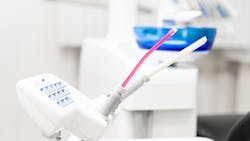Did you know? Suction maintenance will help reduce aerosols in your practice
Protecting your patients and your team from airborne particles and aerosols is an essential part of your infection control protocols. Many dental practitioners focus heavily on the suction tips, particularly those that are comfortable to use, cost-effective, and easy to handle—but properly maintaining the suction and evacuation system is much higher on the importance scale. If the system is not maintained correctly, it can make a simple dental procedure a stressful nightmare because volume decreases and creates improper suction and protection.
A few different parts of the system need regular attention when it comes to cleaning and maintenance. For example, the traps and the suctions lines require frequent cleaning to function to the best of their ability. Knowing your system is the first step in understanding what needs to be maintained to ensure proper flow and function. By following the appropriate maintenance tips and ensuring that the suction lines are running as they should, aerosols, especially those containing bioburden, can be reduced.
The risk of cross-contamination
Cross-contamination is a real threat in dental procedures. Because of the nature of the work, infections and other biohazards can accumulate within suction lines. They can then be transferred into a patient's mouth during the procedure if they are not dealt with appropriately. Research has shown that cross-contamination is a genuine possibility with dental evacuation systems.1
The threat of cross-contamination typically stems from backflow that can get into the suction lines when used with the saliva ejector. When a hygienist tells a patient to place their mouth around the tip of the saliva ejector to remove liquids from the mouth as quickly and efficiently as possible, this increases the risk of backflow into the machine, and the risk of cross-contamination becomes higher.2
Better tools for better disinfection
While disinfection and sterilization are significant components of the cleaning and maintenance of suctioning tools, they’re not the only steps needed to ensure that the machine works as it should to reduce the risk of cross-contamination significantly. Typically, multicomponent suction valves need to be taken apart to be cleaned and disinfected adequately.3 You should confirm this process with the instructions for use.
What you need to do
Aside from understanding how your system works and following the manufacturer's instructions, there are a few other steps to take to ensure that your suction maintenance is up to par. The traps’ location is a vital component to cleaning the system, and you will have to know where they’re located in every room and on the evacuation system. The trap that is on the unit will need to be routinely changed, as is the case with the traps in the rooms housing the system. The equipment's instruction manual should tell you where they are and how often they need to be changed, although typically you should do this once per week.
The entire team should also be aware of a standard operating procedure (SOP) for cleaning the system effectively. Everyone should know what products to use, where they are, the frequency, and instructions on when and how to complete cleaning. The solution used is also a vital part of the process, and if you use an amalgamator, use only compatible products. Products that are neutral on the pH scale and do not contain bleach or other oxidizing agents are standard; avoid soap and other foam solutions because they can affect the system negatively and cause problems that could end up being costly in the future.
The cleaning and sterilization methods you use should also remove bioburden properly without putting strain on the suction system. If there is a failure to decontaminate the equipment fully, it will, in the long run, cause more problems that may be expensive to fix and will jeopardize the effectiveness of the machine.
Following the correct SOPs and protocols for maintaining and decontaminating suction equipment will help keep your patients protected against infection and reduce aerosols in the office.
Editor's note: This article appeared in the July 2021 print edition of RDH.
References
1. Barbeau J, ten Bokum L, Gauthier C, Prévost AP. Cross-contamination potential of saliva ejectors used in dentistry. J Hosp Infection. 1998;40(4):303-311. doi:10.1016/s0195-6701(98)90308-5. 2. Saliva ejector & backflow. CDC. Oral health resource page. Accessed April 7, 2021. https://www.cdc.gov/oralhealth/infectioncontrol/faqs/saliva.html3. Boyle MA, O’Donnell MJ, Russell RJ, Galvin N, Swan D, Coleman DC. Overcoming the problem of residual microbial contamination in dental suction units left by conventional disinfection using novel single component suction handpieces in combination with automated flood disinfection. J Dent. 2015;43(10):1268-1279. doi.org/10.1016/j.jdent.2015.07.018.Michelle Strange, MSDH, RDH, brings over 20 years of experience to her numerous roles in dentistry. A graduate of the Medical University of South Carolina with a bachelor’s of health science and the University of Bridgeport with a master’s in dental hygiene education, she is focused on expanding the knowledge of her colleagues in all aspects of health care. Strange’s passion for dentistry and its connection to overall health extends to her community and global efforts. Currently, she is the cofounder and cohost of the longest-running podcast for dental hygienists, A Tale of Two Hygienists, the cofounder of Level Up Infection Prevention and TriviaDent, a practicing dental hygienist, and client success manager for MouthWatch.
About the Author
Michelle Strange, RDH
Michelle Strange, RDH, is a dedicated dental hygienist and educator passionate about infection control and patient safety. With over 20 years of experience in clinical practice, Michelle is committed to sharing evidence-based solutions to improve dental care outcomes.

